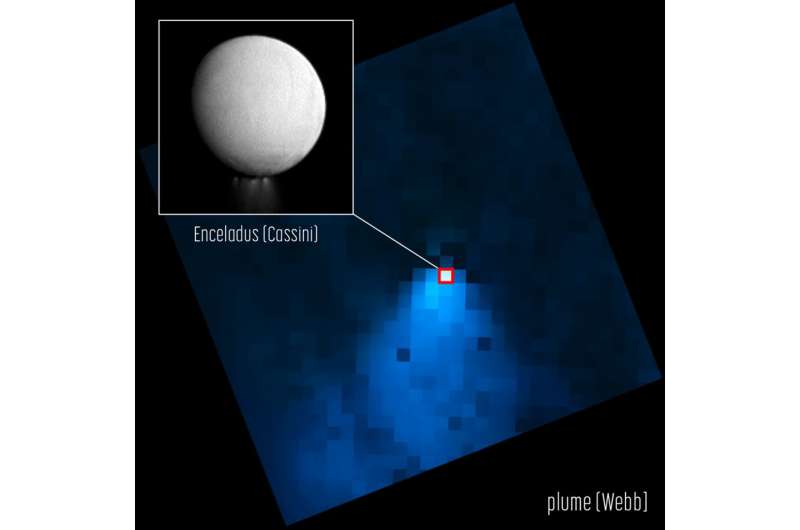
Two Southwest Research Institute scientists were part of a James Webb Space Telescope (JWST) team that observed a towering plume of water vapor more than 6,000 miles long—roughly the distance from the U.S. to Japan—spewing from the surface of Saturn's moon, Enceladus. In light of this NASA JWST Cycle 1 discovery, SwRI's Dr. Christopher Glein also received a Cycle 2 allocation to study the plume as well as key chemical compounds on the surface, to better understand the potential habitability of this ocean world.
During its 13-year reconnaissance of the Saturn system, the Cassini spacecraft discovered that Enceladus has a subsurface ocean of liquid water, and Cassini analyzed samples as plumes of ice grains and water vapor erupted into space from cracks in the moon's icy surface.
"Enceladus is one of the most dynamic objects in the solar system and is a prime target in humanity's search for life beyond Earth," said Glein, a leading expert in extraterrestrial oceanography. He is a co-author of a paper recently accepted by Nature Astronomy. "In the years since NASA's Cassini spacecraft first looked at Enceladus, we never cease to be amazed by what we find is happening on this extraordinary moon."
Once again, the latest observations made with Webb's Near InfraRed Spectrograph have yielded remarkable results.
"When I was looking at the data, at first, I was thinking I had to be wrong, it was just so shocking to map a plume more than 20 times the diameter of the moon," said Geronimo Villanueva of NASA's Goddard Space Flight Center and lead author of the recent paper. "The plume extends far beyond what we could have imagined."
Webb's sensitivity reveals a new story about Enceladus and how it feeds the water supply for the entire system of Saturn and its rings. As Enceladus whips around the gas giant in just 33 hours, the moon spews water, leaving a halo, almost like a donut, in its wake. The plume is not only huge, but the water spreads across Saturn's dense E-ring. JWST data indicate that roughly 30 percent of the water stays in the moon's wake, while the other 70 percent escapes to supply the rest of the Saturnian system.
"The Webb observations, for the first time, are visually illustrating how the moon's water vapor plumes are playing a role in the formation of the torus," said SwRI's Dr. Silvia Protopapa, an expert in the compositional analysis of icy bodies in the solar system who was also on the Cycle 1 team. "This serves as a stunning testament to Webb's extraordinary abilities. I'm thrilled to be part of the Cycle 2 team as we initiate our search for new indications of habitability and plume activity on Enceladus."
Spurred by the incredible findings from Webb's first fleeting glimpse of Enceladus, Glein is leading the same team that will observe Enceladus again with JWST in the next year.
"We will search for specific indicators of habitability, such as organic signatures and hydrogen peroxide," Glein said. "Hydrogen peroxide is particularly interesting because it can provide much more potent sources of metabolic energy than what we previously identified. Cassini didn't give us a clear answer on the availability of such strong oxidants on Enceladus."
The new observations will provide the best remote opportunity to search for habitability indicators on the surface, by boosting the signal-to-noise ratio by up to a factor of 10 compared with Cycle 1. Understanding the time variability of plume outgassing is also important to plan for future planetary science missions that target the plume.
"Webb can serve as a bridge between Cassini and the proposed search-for-life mission, Orbilander," Glein said. "After Cycle 2, we will have a better idea if ocean samples are widely distributed over Enceladus's surface, as opposed to just near the south pole. These next observations could help us determine if Orbilander can access ocean samples near the equator, which may help us get back to Enceladus sooner."
The team's results were accepted for publication on May 17, 2023, in Nature Astronomy, and a pre-print pdf is available.
More information: JWST molecular mapping and characterization of Enceladus' water plume feeding its torus, Nature Astronomy (2023). Preprint: psg.gsfc.nasa.gov/apps/Enceladus_JWST.pdf
Provided by Southwest Research Institute
Citation: Webb telescope finds towering plume of water escaping from one of Saturn's moons (2023, May 30) retrieved 30 May 2023 from https://phys.org/news/2023-05-webb-telescope-towering-plume-saturn.html
This document is subject to copyright. Apart from any fair dealing for the purpose of private study or research, no part may be reproduced without the written permission. The content is provided for information purposes only.
https://news.google.com/rss/articles/CBMiR2h0dHBzOi8vcGh5cy5vcmcvbmV3cy8yMDIzLTA1LXdlYmItdGVsZXNjb3BlLXRvd2VyaW5nLXBsdW1lLXNhdHVybi5odG1s0gFGaHR0cHM6Ly9waHlzLm9yZy9uZXdzLzIwMjMtMDUtd2ViYi10ZWxlc2NvcGUtdG93ZXJpbmctcGx1bWUtc2F0dXJuLmFtcA?oc=5
2023-05-30 16:19:34Z
2045377917
Tidak ada komentar:
Posting Komentar